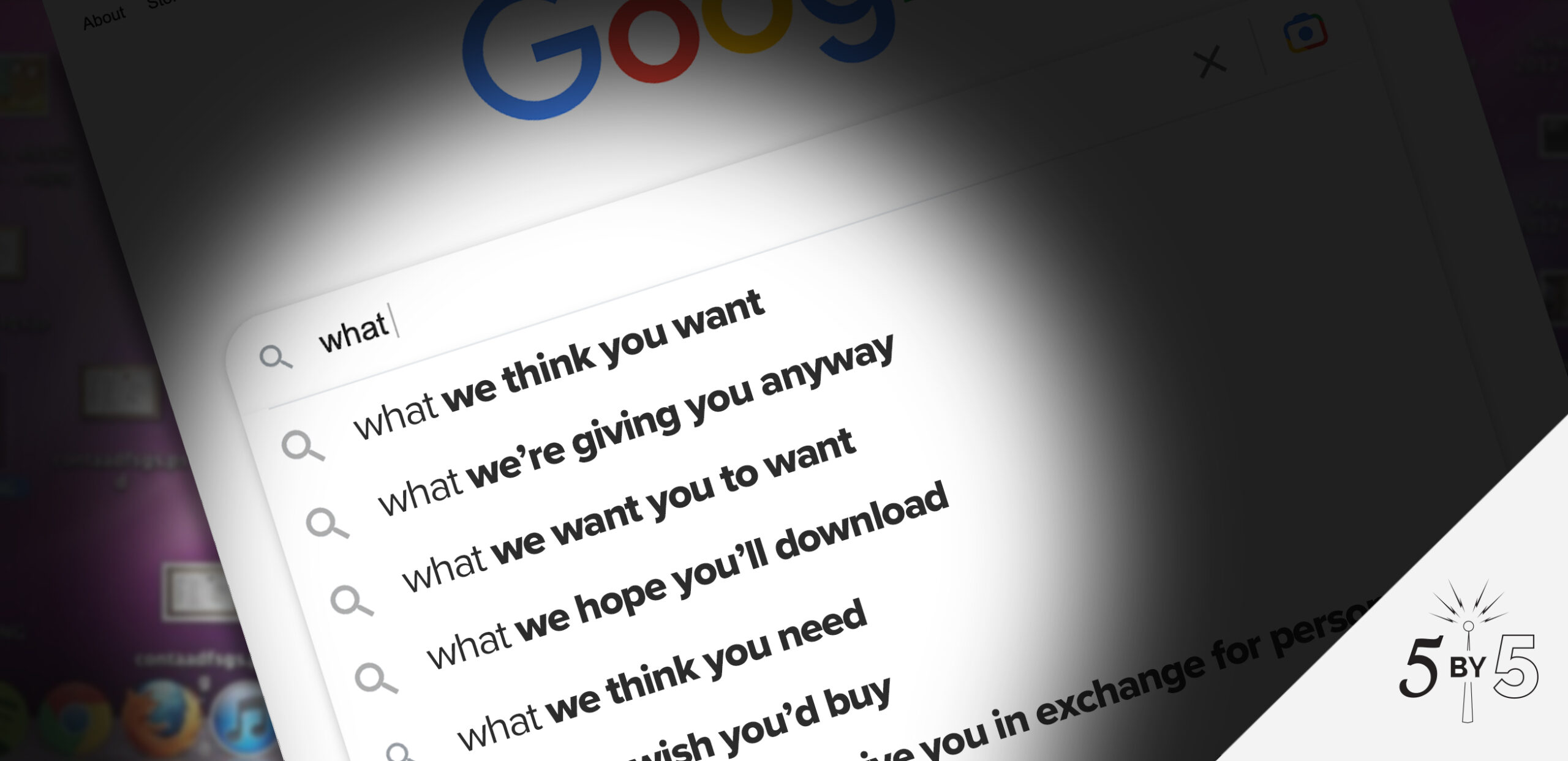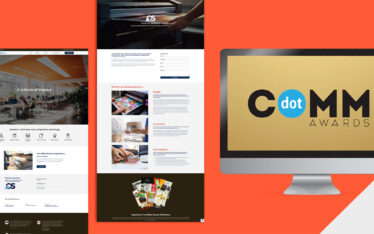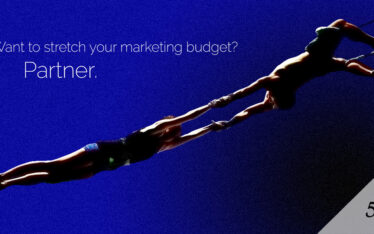
The Intersection of SEO and Search Intent
We’re at the tail-end of a three-month long bathroom remodel, and last week, I performed a Google search for 34” round brushed gold vanity mirrors in an attempt to find some options online.
Wayfair’s site is optimized so that these keyword search terms triggered a first page result. I clicked on the link, found a few mirrors I liked, and saved them in my cart.
This, my friends, is inbound content marketing at work. Wayfair’s SEO game is strong.
I might have done the same at a couple other sites. I might not even remember where I saved them (although I’ve received half a dozen emails from different online shops).
THEN… Yesterday, this postcard arrived in the mail.

This sure looks like a 34” round, brushed gold mirror, doesn’t it?
Wayfair knows my search intent – I’m in the final stages of consideration and ready to buy. Rather than send yet another email to my already overflowing inbox, they dropped a personalized postcard in the mail (the old-fashioned way!). I don’t get much snail mail anymore, so it stood out. The postcard is now sitting on my desk, reminding me to head back to Wayfair and purchase a mirror (thanks, content marketing!).
(Yes, this is an ecommerce B2C example, but it works the same for B2B marketing, so take note!)
Timing is Everything
I was writing this blog post on how SEO + Search Intent combine to create an ideal revenue-generating social media strategy when the postcard arrived: a perfect example, just in time! Here’s how it works:
Search engine optimization helps your brand get found by the right audience at the right time.
Search intent tells you why a buyer is searching. If you know your buyer’s intent, you can optimize with the right keyword research to drive your buyers to the right content.
And this is where most companies fall flat. Their SEO might be strong, but they’re not finding the right buyers and leading them to the right content. If you’re spending a healthy budget on SEO but still aren’t realizing a strong ROI, it’s likely because you’re not marketing at the intersection of SEO and Search Intent.
What are Your Intentions with My … Brand?
Top of funnel brand awareness content is most valuable to the LinkedIn audience, but it’s rarely optimized. Do you know the difference between searching to purchase and searching for knowledge?
According to SEMrush, there are four types of search intent:
Navigational intent = buyer already knows what they’re trying to find and is looking for a specific brand, product, or service.
Informational intent = buyer wants to learn more about a specific topic.
Commercial intent = buyer is researching products or services in order to make an informed purchase decision.
Transactional intent = buyer is searching for a product or service to purchase
When buyers search, they have a user intent in mind. They might just be browsing out of curiosity, interested in discovering more information about something they heard or read, exploring products or services to compare the best fit and pricing for their needs, or looking to make a quick purchase.
In B2B marketing, we know that there’s more than one buyer—usually a committee of 5-8 buyers. Each of them likely has a different objective and different qualifications for signing off on a purchase. But what they all most likely have in common is that the social media platform they spend the most time on is LinkedIn.
Social Media Marketing and Search Intent
And we know from research that most professionals spend time on LinkedIn to uncover insights, build their thought leadership, show their expertise, and network. When they search it’s usually with informational intent – they’re not necessarily searching for information with the future intent to buy. They’re searching for information to gain or show their expertise. They’re thinking of their own career, their own position in the industry. Remember the old adage What’s In It For Me? WIIFM should always be at the center of your content strategy.
Why should you care when their intent is “just” informational? Because grabbing the attention of buyers happens at the intersection of SEO and Search Intent.
You can’t ask your audience what their intent is, but you can look for clues to help determine why they’re searching so that you can design a content strategy—and a user experience—that delivers information that matches their intent.
When it Comes to B2B Marketing, There Are 2 Clues to User Intent
Clue No. 1: Engagements
What are buyers clicking on in their social media feeds? Yes, number of engagements and engagement rates are important, but we need to get granular with metrics and notice what types of engagement(s) each social media post earns:
If you’re content is earning a high number of reactions but no comments… informational intent. The topic is spot on, but the format or information you provided may be wrong for your audience. Take that asset and create derivatives! If it’s a blog post, turn it into a micro-eBook or infographic. If it’s an infographic, turn it into an analyst report or InfoBook.
If your content earns lots of comments and shares… informational intent. Note the keywords you included in that content and the content formats (infographic, eBook, analyst report) they’re social sharing the most.
If saves are racking up for a specific social post… commercial intent! Your buyers will likely be making a purchase soon.
If click-throughs are high but conversions are non-existent or low, your content is probably gated. You should only put content behind a gate if it’s highly valuable (think first party research).
Clue No. 2: Conversations
Social listening takes you one step closer than monitoring. Rather than simply alerting you to brand mentions and what buyers are saying, social media listening lets you in on how buyers feel about your brand, products, services—even the industry as a whole. Imagine knowing:
- What conversations are happening around your brand or within your industry
- The sentiment around these conversations (positive, negative, neutral)
- Which keywords and hashtags buyers use
- Which brands, thought leaders, and influencers buyers are tagging and/or mentioning
- Which keywords and hashtags are most popular with your top competitors
Inbound digital marketing relies on your ability to attract customers by creating valuable content with messaging tailored to not just solve their problems, or meet their needs and wants, but also to the way they prefer to consume content.
And the way to reach those potential customers is to create content that’s optimized for search engines with the right keywords, based on the searcher’s intent.
Start with SEO Strategy
Your content needs to appeal to the Google algorithm and to your target audience. Keyword research is critical, as is high quality content. Stuff your content with too many keywords and not only is the writing weak but your SEO grade plummets. Include too few (or not enough) critical keywords and you’ll be stuck with an asset that’s buried on page 79 of a search engine.
Respondents to our Social Savvy Quiz overwhelmingly said their social media campaigns run for 45 days or fewer. But the B2B buying cycle is significantly longer. A 90-day social media campaign sprint allows for a lot more nurturing of your audience and provides a great deal more information you can use to develop a stronger digital marketing strategy. Uncover:
- What topics buyers are most interested in
- How buyers prefer to consume content
- Which CTAs compel them to act
- Which creative stops the scroll
- The search volume of key phrases and longtail keywords that match buyer intent
- Ideal formats of content assets for each buyer intent
- In-depth social media analysis to determine strengths and opportunities for optimization
Want to control your brand narrative and create content that engages buyers and drives ROI? Start here.
Are you leaving content on the table? Next month we cover content mapping for social media strategy. Stay tuned to the 5BY5!


